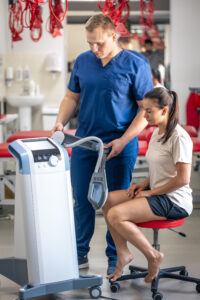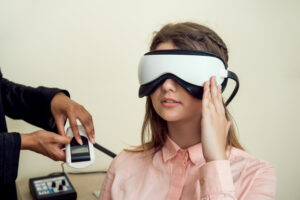When My Heart Rate Monitor Revealed More Than Just Numbers
Picture this: You’re watching your fitness tracker during a particularly stressful day, and you notice your heart rate spiking even while sitting at your desk. That moment of awareness – seeing your body’s invisible responses made visible – captures the essence of what makes biofeedback therapy so powerful.
Last year, millions of people discovered that the same technology monitoring their daily steps could teach them to control functions they never knew were trainable. Your heart rate, muscle tension, breathing patterns, and even brain waves can be measured, displayed, and most importantly, controlled through conscious effort.

This isn’t just another wellness trend. Biofeedback therapy represents a scientifically backed approach that bridges the gap between mind and body, giving you real-time data about your internal processes and teaching you to influence them. Whether you’re battling chronic pain, managing anxiety, or seeking peak performance, understanding how your body communicates can transform your approach to health.
What is Biofeedback Therapy? Understanding the Foundation
Biofeedback therapy is a mind-body technique that enables individuals to gain awareness and control over specific physiological functions to improve health and well-being. The core principle operates on a simple premise: what can be measured can be managed.
Think of biofeedback as having a conversation with your body through technology. Sensors attached to your skin provide real-time information about bodily functions that typically operate below your conscious awareness – heart rate, muscle tension, skin temperature, and breathing patterns.
The Science Behind the Process
During a biofeedback session, specialized sensors monitor your body’s signals and translate them into visual or auditory feedback. This might appear as:
- Visual displays: Changing graphics, light patterns, or screen representations
- Audio signals: Varying tones, beeps, or music volume changes
- Haptic feedback: Vibrations through wearable devices
- Interactive programs: Video games that respond to your physiological state

The immediate feedback allows you to see how different mental states, breathing techniques, or relaxation methods affect your body’s responses. Over time, you develop the ability to create these positive changes without the monitoring equipment.
How Does Biofeedback Therapy Work? The Mechanism Explained
Biofeedback operates through a process called operant conditioning – a learning method that uses immediate feedback to encourage desired behaviors. When you see your heart rate decrease in response to a breathing technique, your brain reinforces that connection.
The Four-Step Process
- Monitoring: Sensors track specific physiological functions
- Display: Real-time data appears on screens or through audio cues
- Learning: You practice techniques to influence these readings
- Integration: Skills become automatic responses you can use anywhere
Your nervous system constantly responds to stress, emotions, and environmental factors. Normally, these responses happen automatically – your heart races during anxiety, muscles tense under pressure, or breathing becomes shallow when overwhelmed. Biofeedback makes these invisible processes visible, allowing you to consciously influence them.
Types of Biofeedback Therapy: Finding Your Perfect Match
Different biofeedback techniques target specific bodily functions, making certain approaches more effective for particular conditions.
Electromyography (EMG) Biofeedback
Function: Measures muscle tension and electrical activity. Applications: Headaches, back pain, muscle spasms, TMJ disorders. Benefits: Highlights muscle activity patterns, facilitating targeted relaxation or strengthening
EMG biofeedback proves particularly valuable for people experiencing chronic pain. By visualizing muscle tension levels, you can identify which muscles contribute to discomfort and learn specific relaxation techniques for those areas.
Thermal Biofeedback
Function: Monitors skin temperature changes. Applications: Migraines, tension headaches, hypertension, Raynaud’s disease. Benefits: Links skin temperature with blood flow and stress levels
Temperature biofeedback works because stress typically reduces blood flow to extremities, lowering skin temperature. Learning to warm your hands or feet indicates improved circulation and relaxation.
Neurofeedback (EEG Biofeedback)
Function: Tracks brain wave activity patterns. Applications: ADHD, insomnia, anxiety, mood disorders, epilepsy. Benefits: Enables cognitive and emotional state regulation through brain function awareness
Neurofeedback represents one of the most sophisticated biofeedback approaches, teaching you to influence brain wave patterns associated with focus, relaxation, or sleep.
[Image placement 4: Diagram showing different types of biofeedback sensors on a human body outline]
Heart Rate Variability (HRV) Biofeedback
Function: Measures intervals between heartbeats. Applications: Anxiety, depression, asthma, cardiovascular issues. Benefits: Demonstrates stress effects on heart rhythm, promoting optimal cardiac function
HRV biofeedback focuses on the natural variation in time between heartbeats, which indicates a healthy, adaptable cardiovascular system.
Respiratory Biofeedback
Function: Monitors breathing patterns and rates. Applications: Anxiety, panic disorders, asthma, sleep issues. Benefits: Encourages consistent, deep, and relaxed breathing patterns
Breathing biofeedback often serves as an entry point for beginners because breathing remains partially under conscious control, making it easier to influence than other physiological functions.
Conditions Treated with Biofeedback Therapy: Evidence-Based Applications
Research supports biofeedback therapy’s effectiveness for numerous health conditions, making it a versatile treatment option.
Chronic Pain Management
Biofeedback shows remarkable success in managing various pain conditions:
- Lower back pain: EMG biofeedback helps identify and release muscle tension patterns
- Fibromyalgia: Multiple biofeedback types address pain, sleep, and stress components
- Temporomandibular joint (TMJ) disorders: Muscle tension awareness reduces jaw clenching
- Chronic headaches: Both tension and migraine headaches respond well to biofeedback training
Anxiety and Stress-Related Disorders
Anxiety disorders benefit significantly from biofeedback because anxiety creates measurable physiological changes. Patients learn to recognize early signs of anxiety through their body’s feedback and implement calming techniques before symptoms escalate.
Cardiovascular Conditions
Heart rate variability biofeedback supports cardiovascular health by:
- Teaching heart rhythm coherence
- Reducing blood pressure in some individuals
- Improving stress resilience
- Supporting recovery from cardiac events
Attention and Focus Issues
Neurofeedback addresses attention deficit hyperactivity disorder (ADHD) by training brain wave patterns associated with focus and attention. Many individuals experience improved concentration and reduced hyperactivity symptoms.
Biofeedback Equipment and Technology: From Clinical to Home Use
Modern biofeedback technology ranges from sophisticated clinical equipment to consumer-friendly home devices.
Clinical-Grade Equipment
Professional biofeedback systems offer:
- Multiple sensor types for comprehensive monitoring
- Advanced software for detailed analysis
- Customizable training protocols
- Real-time data processing and display
Home Biofeedback Devices
The FDA has approved several biofeedback devices for home use:
Resperate: Specifically designed for blood pressure reduction through guided breathing. Heart rate variability monitors: Track heart rhythm patterns for stress management. Breathing pattern devices: Monitor and guide optimal breathing techniques. Wearable sensors: Integrate with smartphone apps for convenient monitoring
Smartphone Apps and Wearable Integration
Modern technology makes biofeedback more accessible through:
- Heart rate monitoring through smartphone cameras
- Breathing pattern apps with visual guides
- Meditation apps with biofeedback components
- Fitness tracker integration for continuous monitoring
The Biofeedback Therapy Session: What to Expect
Understanding the typical biofeedback session helps reduce anxiety and maximize benefits.
Initial Assessment
Your first session includes:
- Medical history review
- Current symptom discussion
- Baseline physiological measurements
- Goal setting and treatment planning
- Introduction to biofeedback concepts
Typical Session Structure
Duration: 30-60 minutes per session Frequency: Usually weekly, sometimes twice weekly Total sessions: 10-20 sessions for most conditions
During each session:
- Sensor placement (painless and non-invasive)
- Baseline measurements
- Guided practice with real-time feedback
- Technique refinement and adjustment
- Home practice assignment

Progress Tracking
Sessions include regular assessment of:
- Physiological improvements
- Symptom reduction
- Skill development
- Home practice effectiveness
Benefits of Biofeedback Therapy: Why It Works
Biofeedback therapy offers unique advantages that distinguish it from other treatment approaches.
Immediate Feedback and Motivation
Unlike traditional therapy methods, biofeedback provides instant confirmation when techniques work effectively. This immediate reinforcement accelerates learning and maintains motivation throughout treatment.
Non-Invasive and Drug-Free
Biofeedback requires no medications, injections, or surgical procedures. This makes it suitable for:
- Pregnant women seeking safe treatment options
- Individuals with medication sensitivities
- People prefer natural health approaches
- Those experiencing medication side effects
Skill Development for Life
Once learned, biofeedback techniques become permanent skills. You can apply these methods anywhere, anytime, without ongoing equipment dependence.
Complementary Treatment Approach
Biofeedback enhances other treatments rather than replacing them. It works alongside:
- Medication management
- Physical therapy
- Psychotherapy
- Lifestyle modifications
Scientific Evidence Supporting Biofeedback Therapy
Extensive research validates biofeedback therapy’s effectiveness across multiple conditions.
Research Highlights
Headache Studies: Meta-analyses show a 40-60% reduction in headache frequency and intensity. Chronic Pain Research: Significant pain reduction in 60-80% of participants. Anxiety Disorders: Measurable improvements in anxiety symptoms and quality of life. ADHD Treatment: Brain wave training shows comparable results to medication in some studies
Long-Term Effectiveness
Follow-up studies demonstrate that biofeedback benefits often persist months or years after treatment completion, indicating lasting physiological and behavioral changes.
Choosing a Qualified Biofeedback Practitioner
Selecting the right practitioner ensures safe, effective treatment.
Essential Qualifications
Look for practitioners with:
- Certification: Board certification in biofeedback (BCB) or equivalent
- Professional licensing: Psychology, physical therapy, nursing, or medicine
- Specialized training: Experience with your specific condition
- Continuing education: Current knowledge of the latest techniques
Questions to Ask Potential Practitioners
Before beginning treatment, inquire about:
- Certification and licensing status
- Experience treating your condition
- Expected number of sessions
- Cost and insurance coverage
- Treatment approach and equipment used
- Success rates with similar cases
Home Practice and Self-Management Techniques
Success with biofeedback therapy extends far beyond clinical sessions through consistent home practice.
Daily Practice Recommendations
Frequency: 10-20 minutes daily, preferably at consistent times. Environment: Quiet, comfortable space free from distractions. Consistency: Regular practice produces better results than sporadic intensive sessions
Integrating Techniques into Daily Life
- Workplace stress management: Quick breathing techniques during breaks
- Sleep preparation: Progressive muscle relaxation before bedtime
- Exercise enhancement: Heart rate variability awareness during workouts
- Social situations: Discrete stress management techniques
Common Misconceptions About Biofeedback Therapy
Addressing frequent misunderstandings helps set realistic expectations.
“Biofeedback is Just Relaxation Training”
While relaxation plays a role, biofeedback involves specific physiological training based on measurable data. It’s more precise and targeted than general relaxation techniques.
“Results Should Be Immediate”
Most people notice some improvements within 2-4 sessions, but significant, lasting changes typically require 8-12 sessions with consistent practice.
“Biofeedback Replaces Medical Treatment”
Biofeedback complements rather than replaces conventional medical care. Always maintain prescribed medications and treatments unless specifically advised otherwise by your healthcare provider.
Cost Considerations and Insurance Coverage
Understanding financial aspects helps with treatment planning.
Typical Costs
Initial assessment: $150-300. Individual sessions: $75-150 per session. Package deals: Often available for multiple sessions. Home equipment: $50-500, depending on sophistication
Insurance Coverage
Many insurance plans cover biofeedback when:
- Prescribed by a physician
- Provided by licensed healthcare professionals
- Used for covered medical conditions
- Part of an approved treatment plan
Contact your insurance provider to verify coverage details and pre-authorization requirements.
Combining Biofeedback with Other Wellness Approaches
Biofeedback integrates well with various health and wellness strategies.
Nutrition and Diet Considerations
Certain dietary factors can enhance biofeedback effectiveness:
- Stable blood sugar: Consistent energy levels support focus during training
- Adequate hydration: Proper hydration affects skin conductance measurements
- Caffeine awareness: Monitor caffeine intake’s impact on heart rate and anxiety levels
- Anti-inflammatory foods: Support overall nervous system health
Exercise and Movement Integration
Physical activity complements biofeedback through:
- Improved body awareness
- Enhanced stress resilience
- Better sleep quality
- Increased overall well-being
Sleep Hygiene Connection
Biofeedback skills often improve sleep quality through:
- Bedtime relaxation routines
- Stress reduction before sleep
- Better awareness of tension patterns
- Improved sleep environment optimization
Potential Limitations and Considerations
While biofeedback offers significant benefits, understanding limitations ensures realistic expectations.
Individual Response Variation
Response to biofeedback varies based on:
- Individual motivation and practice consistency
- Severity and duration of symptoms
- Concurrent medical conditions
- Overall health status
Conditions Requiring Medical Attention
Biofeedback may not be appropriate as a primary treatment for:
- Severe psychiatric conditions
- Acute medical emergencies
- Conditions requiring immediate medication
- Situations involving safety risks
Time and Commitment Requirements
Successful biofeedback therapy requires:
- Regular session attendance
- Consistent home practice
- Patience with gradual progress
Future Developments in Biofeedback Technology
Emerging technologies continue to expand biofeedback possibilities.
Virtual Reality Integration
Virtual reality biofeedback creates immersive environments that respond to physiological changes, making training more engaging and effective.
Artificial Intelligence Applications
AI-powered biofeedback systems provide:
- Personalized training protocols
- Predictive analysis of optimal training times
- Automated progress tracking
- Customized feedback modalities
Wearable Technology Advances
Next-generation wearables offer:
- Continuous physiological monitoring
- Real-time stress alerts
- Seamless integration with daily activities
- Advanced data analytics
Frequently Asked Questions
How long does it take to see results from biofeedback therapy?
Most people notice initial improvements within 2-4 sessions, with significant benefits typically appearing after 6-8 sessions. However, lasting changes often require 10-20 sessions combined with consistent home practice. Factors affecting the timeline include condition severity, practice consistency, and individual responsiveness.
Can children benefit from biofeedback therapy?
Yes, children often respond exceptionally well to biofeedback, particularly for conditions like ADHD, anxiety, bedwetting, and headaches. The visual or game-like feedback appeals to children, making them engaged participants in their treatment. Sessions are typically shorter for children, and family involvement enhances success.
Is biofeedback therapy safe for everyone?
Biofeedback is generally safe and non-invasive with no known side effects. However, certain medical conditions may require precautions. People with cardiac pacemakers, severe psychiatric conditions, or seizure disorders should consult their healthcare provider before beginning biofeedback training.
Can I practice biofeedback techniques without equipment?
Absolutely. The goal of biofeedback training is to develop skills you can use independently. Once you learn to recognize your body’s signals and effective response techniques, you can apply these methods anywhere without equipment. Many people continue using occasional equipment for practice refinement.
How does biofeedback compare to medication for treating anxiety?
Biofeedback and medication address anxiety through different mechanisms. Medication provides faster symptom relief but may cause side effects and doesn’t teach long-term coping skills. Biofeedback takes longer to show effects, but provides lasting skills without side effects. Many people find combining both approaches most effective.
What should I look for in a home biofeedback device?
Consider FDA approval, specific condition targeting, ease of use, data tracking capabilities, and professional support availability. Start with simpler devices focusing on one or two functions rather than complex multi-sensor systems. Ensure the device provides clear, actionable feedback rather than just data collection.
Taking the Next Step: Your Biofeedback Journey Begins
Biofeedback therapy offers a unique opportunity to develop greater awareness and control over your body’s responses to stress, pain, and other challenges. Unlike passive treatments, biofeedback empowers you with skills that last a lifetime.
Whether you’re seeking relief from chronic pain, better stress management, improved focus, or enhanced performance, biofeedback provides measurable, evidence-based techniques for achieving your goals. The combination of real-time feedback, professional guidance, and personal practice creates a powerful platform for positive change.
Remember that successful biofeedback therapy requires patience, practice, and persistence. The skills you develop through biofeedback training become valuable tools you can access anywhere, anytime, providing a sense of control and confidence in managing your health.
If you’re considering biofeedback therapy, consult with qualified healthcare professionals to determine if this approach aligns with your health goals and current treatment plan. Many people find that biofeedback not only addresses their specific symptoms but also provides broader benefits in stress management, body awareness, and overall well-being.
Your journey toward better health and greater body awareness can begin today. Take the first step by researching qualified practitioners in your area or exploring reputable home biofeedback options that align with your specific needs and goals.